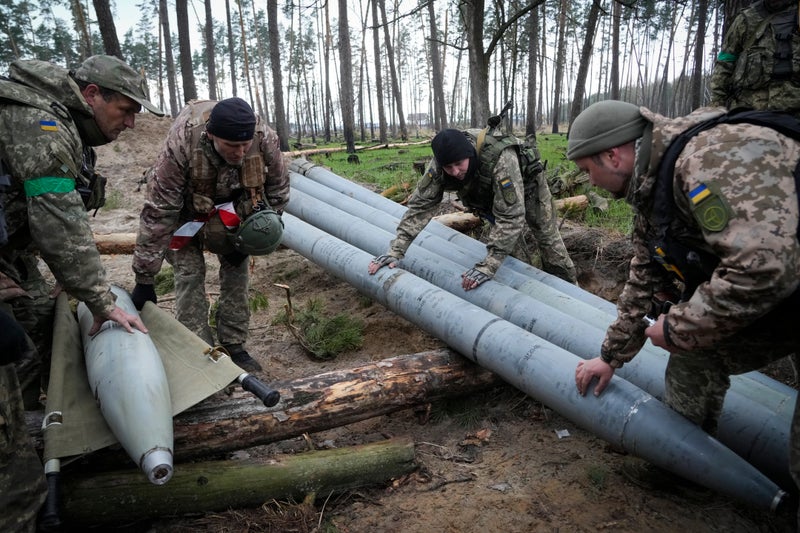To view this video please enable JavaScript, and consider upgrading to a web browser that supports HTML5 video. Up Next. Tracking Vladimir Putin’s full-scale invasion of Ukraine is a brutal task as blood is spilled like water for mere metres of land on the frontline. But the broader picture is stark. Since 2014, Russia has gradually occupied more and more Ukrainian territory, without much intervention from Western powers.
![[METRO GRAPHICS Control of terrirtory Russia Ukraine 2025]](https://metro.co.uk/wp-content/uploads/2025/02/SEI_240333151-236e.jpg?quality=90&strip=all&w=646)
First came the illegal annexation of Crimea in March 2014, then the fall of parts of the eastern region of Donbas to Russian-backed separatists the same year. Now, almost three years to the day into the invasion, Russian forces hold a fifth of internationally recognised Ukrainian territory, including key cities in Donetsk, Luhansk, Zaporizhzhia and Kherson regions. And it is unlikely that Putin will relinquish these battlefield gains during the upcoming peace talks in Saudi Arabia.
Here is a recap of what has happened in the last three years and what land Ukraine is hoping to have returned as part of a deal brokered by the US. Up until 2014, Ukraine’s borders had remained unbreeched since it gained independence from the Soviet Union in 1991. That changed overnight when Russia seized Crimea in March that year on the pretense of protecting the rights of Russian citizens and speakers in the region at the time.
As much as 10,400 square miles – strategically bordering the Black Sea and the Sea of Azov – were illegally annexed and around 2.4 million people absorbed into Russia. It was not long after that Russian-backed separatists took control of parts of Donetsk and Luhansk, igniting a war that carved away more Ukrainian territory, leaving millions of Ukrainians displaced. By the time Putin launched his full-scale invasion in 2022, 7% of Ukrainian territory had been lost.
Shielded by the darkness of the night, the first Russian tanks rolled into eastern Ukraine on February 24, 2022, marking the start of the full-scale war. Dozens of missiles rained on cities all over Ukraine before dawn, meeting strong resistance straightaway, proving that – unlike Putin had famously vowed – Ukraine will not fall by the end of the week. Soldiers later failed to take over the capital Kyiv, but committed some of the worst war atrocities in Ukraine just 20 miles on the outskirts in Bucha.
There – in mass graves – hundreds, if not thousands, of Ukrainian civilians were executed. In the south, Russia devastated Mariupol, relentlessly bombing the city and besieging the Azovstal steel plant before taking full control in May. In 2023, Russia redirected its focus on entirely crippling Ukraine’s energy infrastructure and leaving millions of people without electricity during the harsh eastern winter.
Wagner mercenaries were deployed to the frontlines in Ukraine for further territorial gain. In eastern Ukraine, the battle to save the ruined city of Bakhmut turned into a months-long bloodbath until it was largely captured in May. Russia made steady advances in 2024 as Ukraine grappled with dwindling military aid as Western leaders debated what weapons should be allowed for use in the war. Looking at a map of Ukraine before February 2014, it is a stark reminder about how much can change in a decade during an invasion.
Currently, Russia controls about 20% of Ukrainian territory, with a third of that annexed before the beginning of the full-scale invasion. Ukraine itself holds several thousand square miles of Russian land, in the border region of Kursk, which it invaded in 2024 to potentially trade during future negotiations for peace. Away from territory gains, 3.6 million people have been displaced within Ukraine, and another 6.5 million have fled abroad.
Out of these 6.5 million refugees, 90% are women and children, with 59% of internally displaced persons being women. At least 74% of those in Ukraine report separation from a close family member due to conflict. Get in touch with our news team by emailing us at webnews@metro.co.uk. For more stories like this, check our news page. Arrow MORE: Sir Keir greets Macron ahead of Ukraine talks – and everyone is saying the same thing.
Arrow MORE: Nuclear expert issues Chernobyl update after it emerges fires are still burning. Arrow MORE: New evidence reveals Putin critic Alexei Navalny ‘was poisoned before his death’. Never miss the biggest stories with breaking news alerts in your inbox. This site is protected by reCAPTCHA and the Google Privacy Policy and Terms of Service apply. Your information will be used in line with our Privacy Policy.































